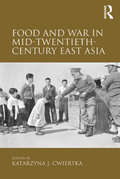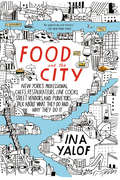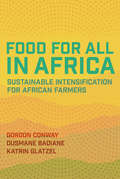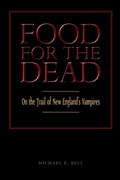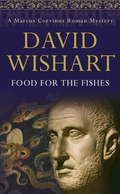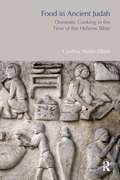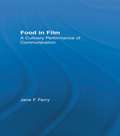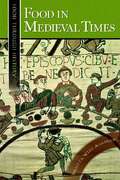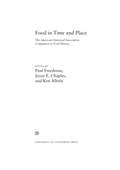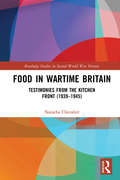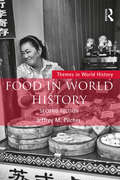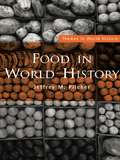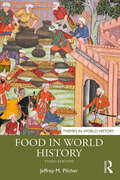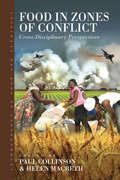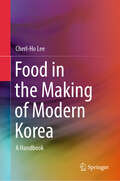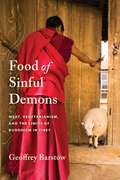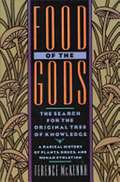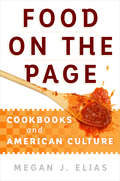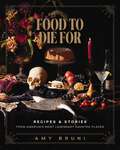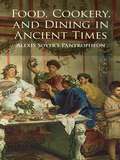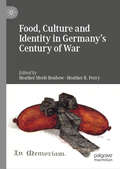- Table View
- List View
Food and War in Mid-Twentieth-Century East Asia
by Katarzyna J. CwiertkaWar has been both an agent of destruction and a catalyst for innovation. These two, at first sight contradictory, yet mutually constitutive outcomes of war-waging are particularly pronounced in twentieth-century Asia. While 1945 marked the beginning of peaceful recovery for Europe, military conflicts continued to play a critical role in the historical development of this part of the world. In essence, all wars in twentieth-century Asia stemmed from the political vacuum that developed after the fall of the Japanese Wartime Empire, intricately connecting one region with another. Yet, they have had often very diverse consequences, shattering the homes of some and bringing about affluence to others. Disarray of war may halt economic activities and render many aspects of life insignificant. The need for food, however, cannot be ignored and the social action that it requires continues in all circumstances. This book documents the effects of war on the lives of ordinary people through the investigation of a variety of connections that developed between war-waging and the production, distribution, preparation and consumption of food throughout Asia since the 1930s. The topics addressed range from issues at stake at the time of the conflicts, such as provisioning the troops and food rationing and food relief for civilians, to long-term, often surprising consequences of war waging and wartime mobilization of resources on the food systems, diets, and tastes of the societies involved. The main argument of this volume is that war has not been a mere disruption, but rather a central force in the social and cultural trajectories of twentieth-century Asia. Due to its close connection with human nourishment and comfort, food stands central in the life of the individual. On the other hand, owing to its connection with profit and power, food plays a critical role in the social and economic organization of a society. What happens to food and eating is, therefore, an important index of change, a privileged basis for the exploration of historical processes.
Food and the City: New York's Professional Chefs, Restaurateurs, Line Cooks, Street Vendors, and Purveyors Talk About What They Do and Why They Do It
by Ina YalofAn unprecedented behind-the-scenes tour of New York City's dynamic food culture, as told through the voices of the chefs, line cooks, restaurateurs, waiters, and street vendors who have made this industry their lives. In Food and the City, Ina Yalof takes us on an insider's journey into New York's pulsating food scene alongside the men and women who call it home. Dominique Ansel declares what great good fortune led him to make the first cronut. Lenny Berk explains why Woody Allen's mother would allow only him to slice her lox at Zabar's. Ghaya Oliveira, who came to New York as a young Tunisian stockbroker, opens up about her hardscrabble yet swift trajectory from dishwasher to executive pastry chef at Daniel. Restaurateur Eddie Schoenfeld describes his journey from Nice Jewish Boy from Brooklyn to New York's Indisputable Chinese Food Maven.From old-schoolers such as David Fox, third-generation owner of Fox's U-bet syrup, and the outspoken Upper West Side butcher "Schatzie," to new kids on the block including Patrick Collins, sous chef at The Dutch, and Brooklyn artisan Lauren Clark of Sucre Mort Pralines, Food and the City is a fascinating oral history with an unforgettable gallery of New Yorkers who embody the heart and soul of a culinary metropolis.From the Hardcover edition.
Food and the City: New York's Professional Chefs, Restaurateurs, Line Cooks, Street Vendors, and Purveyors Talk About What They Do and Why They Do It
by Ina YalofA behind-the-scenes tour of New York City's dynamic food culture, as told through the voices of the chefs, line cooks, restaurateurs, waiters, and street vendors who have made this industry their lives."A must-read -- both for those who live and dine in NYC and those who dream of doing so." --Bustle"[A] compelling volume by a writer whose beat is not food . . . with plenty of opinions to savor." --Florence Fabricant, The New York TimesIn Food and the City, Ina Yalof takes us on an insider's journey into New York's pulsating food scene alongside the men and women who call it home. Dominique Ansel declares what great good fortune led him to make the first Cronut. Lenny Berk explains why Woody Allen's mother would allow only him to slice her lox at Zabar's. Ghaya Oliveira, who came to New York as a young Tunisian stockbroker, opens up about her hardscrabble yet swift trajectory from dishwasher to executive pastry chef at Daniel. Restaurateur Eddie Schoenfeld describes his journey from Nice Jewish Boy from Brooklyn to New York's Indisputable Chinese Food Maven.From old-schoolers such as David Fox, third-generation owner of Fox's U-bet syrup, and the outspoken Upper West Side butcher "Schatzie" to new kids on the block including Patrick Collins, sous chef at The Dutch, and Brooklyn artisan Lauren Clark of Sucre Mort Pralines, Food and the City is a fascinating oral history with an unforgettable gallery of New Yorkers who embody the heart and soul of a culinary metropolis.From the Hardcover edition.
Food for All in Africa: Sustainable Intensification for African Farmers
by Ousmane Badiane Gordon Conway Katrin GlatzelAfrica requires a new agricultural transformation that is appropriate for Africa, that recognizes the continent's diverse environments and climates, and that takes into account its histories and cultures while benefiting rural smallholder farmers and their families.In this boldly optimistic book, Sir Gordon Conway, Ousmane Badiane, and Katrin Glatzel describe the key challenges faced by Africa's smallholder farmers and present the concepts and practices of Sustainable Intensification (SI) as opportunities to sustainably transform Africa's agriculture sector and the livelihoods of millions of smallholders. The way forward, they write, will be an agriculture sector deeply rooted within SI: producing more with less, using fertilizers and pesticides more prudently, adapting to climate change, improving natural capital, adopting new technologies, and building resilience at every stage of the agriculture value chain.Food for All in Africa envisions a virtuous circle generated through agricultural development rooted in SI that results in greater yields, healthier diets, improved livelihoods for farmers, and sustainable economic opportunities for the rural poor that in turn generate further investment. It describes the benefits of digital technologies for farmers and the challenges of transforming African agricultural policies and creating effective and inspiring leadership.Food for All in Africa demonstrates why we should take on the challenge and provides ideas and methods through which it can be met.
Food for Dissent: Natural Foods and the Consumer Counterculture Since the 1960s
by Maria McGrathIn the 1960s and early 1970s, countercultural rebels decided that, rather than confront the system, they would create the world they wanted. The natural foods movement grew out of this contrarian spirit. Through a politics of principled shopping, eating, and entrepreneurship, food revolutionaries dissented from corporate capitalism and mainstream America. In Food for Dissent, Maria McGrath traces the growth of the natural foods movement from its countercultural fringe beginning to its twenty-first-century "food revolution" ascendance, focusing on popular natural foods touchstones—vegetarian cookbooks, food co-ops, and health advocates. Guided by an ideology of ethical consumption, these institutions and actors spread the movement's oppositionality and transformed America's foodscape, at least for some. Yet this strategy proved an uncertain instrument for the advancement of social justice, environmental defense, and anti-corporatism. The case studies explored in Food for Dissent indicate the limits of using conscientious eating, shopping, and selling as tools for civic activism.
Food for People, Not for Profit
by Michael Jacobson Catherine LerzaA sourcebook for the Food Crisis. Includes a preface by Ralph Nader.
Food for the Dead: On the Trail of New England’s Vampires (Garnet Bks.)
by Michael E. BellFor nineteenth-century New Englanders, "vampires" lurked behind tuberculosis. To try to rid their houses and communities from the scourge of the wasting disease, families sometimes relied on folk practices, including exhuming and consuming the bodies of the deceased. Author and folklorist Michael E. Bell spent twenty years pursuing stories of the vampire in New England. While writers like H. P. Lovecraft, Henry David Thoreau, and Amy Lowell drew on portions of these stories in their writings, Bell brings the actual practices to light for the first time. He shows that the belief in vampires was widespread, and, for some families, lasted well into the twentieth century. With humor, insight, and sympathy, he uncovers story upon story of dying men, women, and children who believed they were food for the dead. This Wesleyan paperback edition includes an extensive preface by the author unveiling some of the new cases he's learned about since Food for the Dead was first published in 2001.
Food for the Fishes
by David WishartWhen Licinius Murena, wealthy owner of a fish-farm, is found dead, drowned in one of his own eel tanks, not many tears are shed. Certainly not by Trebbio, who had just been booted out of his cottage by the landowner, and was heard bad-mouthing him drunkenly in public the day before Murena's death. Nor by the widow, a little stunner half Murena's age who allegedly spent an inordinate amount of time 'under the doctor'. Nor by his daughter or his farm manager. With friends like these, who needs enemies? Marcus Corvinus is the man to find out. With the help, of course, of his clever wife Perilla - if she can spare the time from her newly acquired passion for gambling . . . As we follow the Byzantine thought processes by which our hero solves the crime, we are entertained along with way with accounts of pisciculture and with a handy guide to 'Twelve Lines', the Roman precursor of backgammon.
Food for the Fishes
by David WishartWhen Licinius Murena, wealthy owner of a fish-farm, is found dead, drowned in one of his own eel tanks, not many tears are shed. Certainly not by Trebbio, who had just been booted out of his cottage by the landowner, and was heard bad-mouthing him drunkenly in public the day before Murena's death. Nor by the widow, a little stunner half Murena's age who allegedly spent an inordinate amount of time 'under the doctor'. Nor by his daughter or his farm manager. With friends like these, who needs enemies? Marcus Corvinus is the man to find out. With the help, of course, of his clever wife Perilla - if she can spare the time from her newly acquired passion for gambling . . . As we follow the Byzantine thought processes by which our hero solves the crime, we are entertained along with way with accounts of pisciculture and with a handy guide to 'Twelve Lines', the Roman precursor of backgammon.
Food in Ancient Judah: Domestic Cooking in the Time of the Hebrew Bible
by Cynthia Shafer-ElliottFirst published in 2013. The study of food in the Hebrew Bible and Syro-Palestinian archaeology has tended to focus on kosher dietary laws, the sacrificial system, and feasting in elite contexts. More everyday ritual and practice - the preparation of food in the home - has been overlooked. Food in Ancient Judah explores both the archaeological remains and ancient Near Eastern sources to see what they reveal about the domestic gastronomical daily life of ancient Judahites within the narratives of the Hebrew Bible. Beyond the findings, the methodology of the study is in itself innovative. Biblical passages that deal with domestic food preparation are translated and analysed. Archaeological findings and relevant secondary resources are then applied to inform these passages. Food in Ancient Judah reflects both the shift towards the study of everyday life in biblical studies and archaeology and the huge expansion of interest in food history - it will be of interest to scholars in all these fields
Food in Film: A Culinary Performance of Communication (Studies in American Popular History and Culture)
by Jane FerryFirst published in 2003. Routledge is an imprint of Taylor & Francis, an informa company.
Food in Medieval Times
by Melitta Weiss AdamsonFew medieval cookbooks have survived from earlier than the 14th century and those typically reflect the cuisine of the elite. In a study of culture in the Middle Ages viewed through food-related themes, Adamson (modern languages and literatures, U. of Western Ontario) describes the cultivation and use of various foodstuffs, cooking methods, cuisines of several European countries, eating habits, and notions about nutrition. She includes a timeline, period illustrations, glossary, suggested further reading, and an index of such recipes as eel pie and stuffed buried Jewish dish (a stew). Annotation ©2004 Book News, Inc., Portland, OR (booknews.com)
Food in Time and Place
by Ken Albala Joyce E. Chaplin Paul FreedmanFood and cuisine are important subjects for historians across many areas of study. Food, after all, is one of the most basic human needs and a foundational part of social and cultural histories. Such topics as famines, food supply, nutrition, and public health are addressed by historians specializing in every era and every nation.Food in Time and Place delivers an unprecedented review of the state of historical research on food, endorsed by the American Historical Association, providing readers with a geographically, chronologically, and topically broad understanding of food cultures--from ancient Mediterranean and medieval societies to France and its domination of haute cuisine. Teachers, students, and scholars in food history will appreciate coverage of different thematic concerns, such as transfers of crops, conquest, colonization, immigration, and modern forms of globalization.
Food in Wartime Britain: Testimonies from the Kitchen Front (1939–1945) (Routledge Studies in Second World War History)
by Natacha ChevalierBased on deep analysis of Mass Observation wartime diaries, Food in Wartime Britain explores the food experience of the British middle classes in their own words throughout the course of the Second World War. It reveals that, while the food practices of the population were modified by rationing and food scarcity, social class and personal circumstances were key dimensions of the wartime food experience that demand to be taken into account in the historical narrative of the Home Front.
Food in World History
by Jeffrey M. PilcherThe second edition of this concise survey offers a comparative and comprehensive study of culinary cultures and food politics throughout the world, from ancient times to the present day. It examines the long history of globalization of foods as well as the political, social, and environmental implications of our changing relationship with food, showing how hunger and taste have been driving forces in human history.? Including numerous case studies from diverse societies and periods, Food in World History explores such questions as: What social factors have historically influenced culinary globalization? How did early modern plantations establish patterns for modern industrial food production? Were eighteenth-century food riots comparable to contemporary social movements around food? Did Italian and Chinese migrant cooks sacrifice authenticity to gain social acceptance in the Americas? Have genetically modified foods fulfilled the promises made by proponents? This new edition includes expanded discussions of gender and the family, indigeneity, and the politics of food. Expanded chapters on contemporary food systems and culinary pluralism examine debates over the concentration of corporate control over seeds and marketing, authenticity and exoticism within the culinary tourism industry, and the impact of social media on restaurants and home cooks.
Food in World History (Themes in World History)
by Jeffrey M. PilcherProviding a comparative and comprehensive study of culinary cultures and consumption throughout the world from ancient times to present day, this book examines the globalization of food and explores the political, social and environmental implications of our changing relationship with food. Including numerous case studies from diverse societies and periods, Food in World History examines and focuses on: how food was used to forge national identities in Latin America the influence of Italian and Chinese Diaspora on the US and Latin America food culture how food was fractured along class lines in the French bourgeois restaurant culture and working class cafes the results of state intervention in food production how the impact of genetic modification and food crises has affected the relationship between consumer and product. This concise and readable survey not only presents a simple history of food and its consumption, but also provides a unique examination of world history itself.
Food in World History (Themes in World History)
by Jeffrey M. PilcherNow in its third edition, Food in World History explores culinary cultures and food politics throughout the world, from ancient times to the present day, with expanded discussions of industrialization, indigeneity, colonialism, gender, environment, and food and power. It examines the long history of globalization of foods as well as the political, social, and environmental implications of our changing relationship with food, showing how hunger and taste have been driving forces in human history. Including numerous case studies from diverse societies and periods, such as Maya and Inca cuisines and peasant agriculture in the early modern era, Food in World History explores such questions as: What social factors have historically influenced culinary globalization? How did early modern plantations establish patterns for modern industrial food production? How will the climate crisis affect food production and culinary cultures? Did Italian and Chinese migrant cooks sacrifice authenticity to gain social acceptance in the Americas? Have genetically modified foods fulfilled the promises made by proponents? With the inclusion of more global examples, this comprehensive survey is an ideal resource for all students who study food history or food studies.
Food in Zones of Conflict: Cross-Disciplinary Perspectives (Anthropology of Food & Nutrition #8)
by Helen Macbeth Paul CollinsonThe availability of food is an especially significant issue in zones of conflict because conflict nearly always impinges on the production and the distribution of food, and causes increased competition for food, land and resources Controlling the production of and access to food can also be used as a weapon by protagonists in conflict. The logistics of supply of food to military personnel operating in conflict zones is another important issue. These themes unite this collection, the chapters of which span different geographic areas. This volume will appeal to scholars in a number of different disciplines, including anthropology, nutrition, political science, development studies and international relations, as well as practitioners working in the private and public sectors, who are currently concerned with food-related issues in the field.
Food in the Making of Modern Korea: A Handbook
by Cherl-Ho LeeThis handbook offers an updated and comprehensive presentation of knowledge on Korean modern and contemporary food history. It covers the changes in food availability, nutrition, and the health status of Koreans, and the Korean food industry's development from the late period of Joseon dynasty in the mid-19th century, to the present. This period includes the severe poverty and food shortage of the Joseon dynasty, followed by the Japanese invasion, Independence and the South-North division, the Korean war, and rapid industrial development. The influence of national and international environments and political changes during the last 150 years on the Korean food security and the nutritional situation of the people is demarcated. In doing so, the author makes novel suggestions on possible contributions to alleviate the world food crisis in the future. Relevant to food historians and food scientists, and East Asian studies scholars with a particular interest in Korean culture and history,this is a pioneering work that elucidates the driving forces for the development and betterment of Korean society—through food acquisition.
Food of Sinful Demons: Meat, Vegetarianism, and the Limits of Buddhism in Tibet (Studies of the Weatherhead East Asian Institute, Columbia University)
by Geoffrey BarstowTibetan Buddhism teaches compassion toward all beings, a category that explicitly includes animals. Slaughtering animals is morally problematic at best and, at worst, completely incompatible with a religious lifestyle. Yet historically most Tibetans—both monastic and lay—have made meat a regular part of their diet. In this study of the place of vegetarianism within Tibetan religiosity, Geoffrey Barstow explores the tension between Buddhist ethics and Tibetan cultural norms to offer a novel perspective on the spiritual and social dimensions of meat eating.Food of Sinful Demons shows the centrality of vegetarianism to the cultural history of Tibet through specific ways in which nonreligious norms and ideals shaped religious beliefs and practices. Barstow offers a detailed analysis of the debates over meat eating and vegetarianism, from the first references to such a diet in the tenth century through the Chinese invasion in the 1950s. He discusses elements of Tibetan Buddhist thought—including monastic vows, the Buddhist call to compassion, and tantric antinomianism—that see meat eating as morally problematic. He then looks beyond religious attitudes to examine the cultural, economic, and environmental factors that oppose the Buddhist critique of meat, including Tibetan concepts of medicine and health, food scarcity, the display of wealth, and idealized male gender roles. Barstow argues that the issue of meat eating was influenced by a complex interplay of factors, with religious perspectives largely supporting vegetarianism while practical concerns and secular ideals pulled in the other direction. He concludes by addressing the surge in vegetarianism in contemporary Tibet in light of evolving notions of Tibetan identity and resistance against the central Chinese state. The first book to discuss this complex issue, Food of Sinful Demons is essential reading for scholars interested in Tibetan religion, history, and culture as well as global food history.
Food of the Gods: The Search for the Original Tree of Knowledge a Radical History of Plants, Drugs, and Human Evolution
by Terence McKennaAn exploration of humans' symbiotic relationships with plants and chemicals presents information on prehistoric partnership societies, the roles of spices and spirits in the rise of dominator societies; and the politics of tobacco, tea, coffee, opium, and alcohol. <p><p> Why, as a species, are humans so fascinated by altered states of consciousness? Can altered states reveal something to us about our origins and our place in nature? In Food of the Gods, ethnobotanist Terence McKenna's research on man's ancient relationship with chemicals opens a doorway to the divine, and perhaps a solution for saving our troubled world. McKenna provides a revisionist look at the historical role of drugs in the East and the West, from ancient spice, sugar, and rum trades to marijuana, cocaine, synthetics, and even television--illustrating the human desire for the "food of the gods" and the powerful potential to replace abuse of illegal drugs with a shamanic understanding, insistence on community, reverence for nature, and increased self-awareness.
Food on the Page: Cookbooks and American Culture
by Megan J. EliasWhat is American food? From barbecue to Jell-O molds to burrito bowls, its history spans a vast patchwork of traditions, crazes, and quirks. A close look at these foods and the recipes behind them unearths a vivid map of American foodways: how Americans thought about food, how they described it, and what foods were in and out of style at different times.In Food on the Page, the first comprehensive history of American cookbooks, Megan J. Elias chronicles cookbook publishing from the early 1800s to the present day. Following food writing through trends such as the Southern nostalgia that emerged in the late nineteenth century, the Francophilia of the 1940s, countercultural cooking in the 1970s, and today's cult of locally sourced ingredients, she reveals that what we read about food influences us just as much as what we taste.Examining a wealth of fascinating archival material—and rediscovering several all-American culinary delicacies and oddities in the process—Elias explores the role words play in the creation of taste on both a personal and a national level. From Fannie Farmer to The Joy of Cooking to food blogs, she argues, American cookbook writers have commented on national cuisine while tempting their readers to the table. By taking cookbooks seriously as a genre and by tracing their genealogy, Food on the Page explains where contemporary assumptions about American food came from and where they might lead.
Food to Die For: Recipes and Stories from America's Most Legendary Haunted Places
by Amy BruniDiscover tantalizing recipes, spine-tingling stories, and historic photos from the most notoriously haunted locations across America in this fun and fascinating cookbook. Paranormal investigator and Kindred Spirits co-host Amy Bruni leads you through eerie hotels, haunted homes, hellish hospitals, and spooky ghost towns, giving you stories and a recipe from each place.Whether you're in the mood for Lizzie Borden's meatloaf or want to serve up spooky prison stories along with sugar cookies from Alcatraz, Food to Die For is your guide to ghoulish gastronomy.One of America's favorite ghost hunters, Amy Bruni takes you to mysterious hotels, eerie ghost towns, and possessed pubs in this delightfully sinister collection of stories and recipes. Each of the nearly 60 locations in Food to Die For includes:Vintage photographs and charmingly creepy stories rooted in historyA noteworthy recipe associated with the people or placeFull-color, captivating, and hauntingly styled food photos to inspire a killer kitchen experience Enjoy creepy recipes like:Southern Fried Chicken from the Missouri State PenitentiarySheboygan Asylum Caesar SaladCornbread inspired by the Villisca Axe Murder HouseAbsinthe Frappé from the Old Absinthe HouseErnest Hemingway's Bloody Mary from Hemingway Home & MuseumVegetable Soup from Waverly Hills Sanatorium This terrifyingly tasty cookbook will bewitch anyone who:Has a taste for the paranormal and a hunger to try new foodsLoves history, travel, and culinary curiositiesEnjoys entertaining guests in unique and memorable waysWould get goosebumps making a recipe written 300 years ago History buffs, thrill-seekers, and foodies will all get shivers seeing the past come to life with every enchanted recipe and delicious tale from Food to Die For.
Food, Cookery, and Dining in Ancient Times: Alexis Soyer's Pantropheon
by Alexis Soyer"Tell me what thou eatest," Alexis Soyer declared in a familiar refrain, "and I will tell thee who thou art." In his book Pantropheon, originally published in 1853, the flamboyant Frenchman (and world's first celebrity chef) ventures to answer that question as he presents a wealth of entertaining and enlightening information on what food the people of ancient civilizations ate and how they prepared it.Describing the culinary achievements of the Greeks, Romans, Assyrians, Egyptians, and Jews, Soyer covers such topics as the mythological origin of specific foods (pomegranates and eels, for example); agricultural, milling, and marketing practices; descriptions of seasonings, pastries, and exotic dishes; the treatment of dinner guests; as well as suggestions for serving pigeon, peacock, wild boar, camel, elephant, flamingo, and other wildlife.Enhanced by 38 illustrations depicting food-related objects and antiquity's gastronomic wonders, this witty and literal study of epicurean delights will charm history buffs and food enthusiasts alike.
Food, Culture and Identity in Germany's Century of War
by Heather Merle Benbow Heather R. PerryEven in the harsh conditions of total war, food is much more than a daily necessity, however scarce—it is social glue and an identity marker, a form of power and a weapon of war. This collection examines the significance of food and hunger in Germany’s turbulent twentieth century. Food-centered perspectives and experiences “from below” reveal the social, cultural and political consequences of three conflicts that defined the twentieth century: the First and Second World Wars and the ensuing global Cold War. Emerging and established scholars examine the analytical salience of food in the context of twentieth-century Germany while pushing conventional temporal frameworks and disciplinary boundaries. Together, these chapters interrogate the ways in which deeper studies of food culture in Germany can shed new light on old wars.
